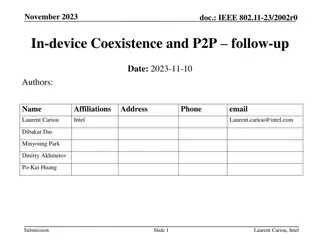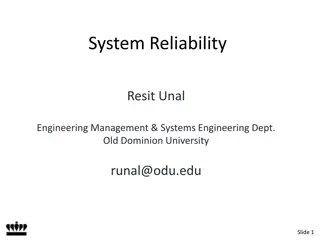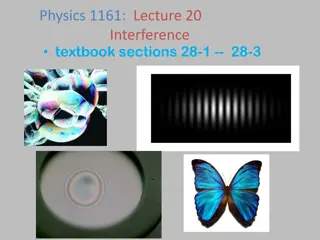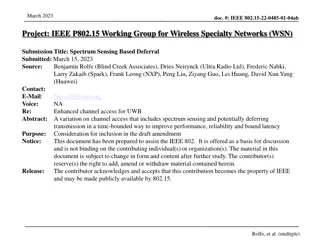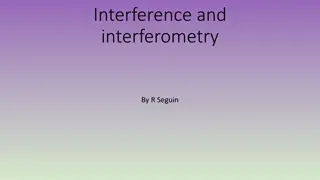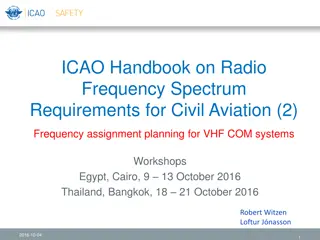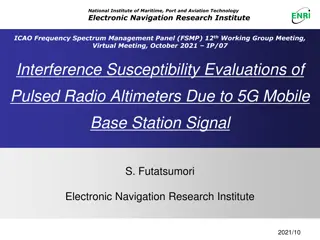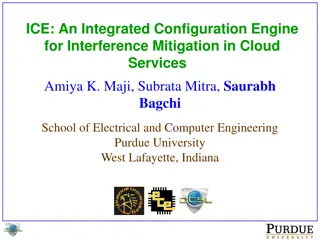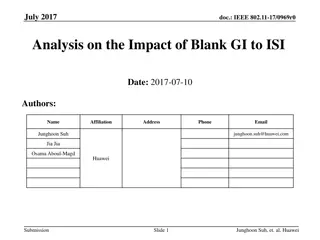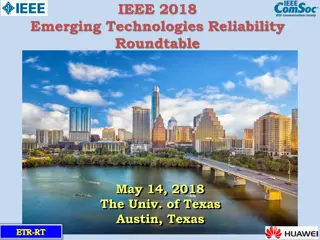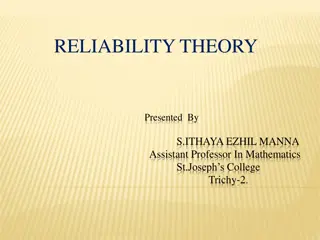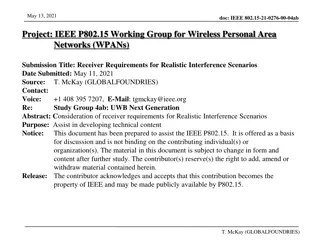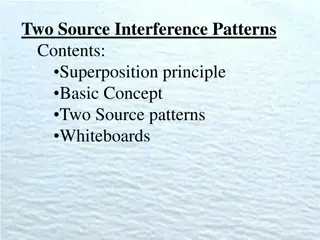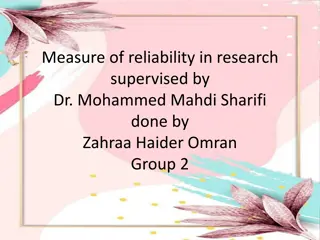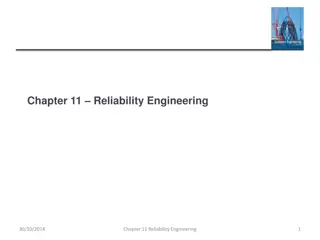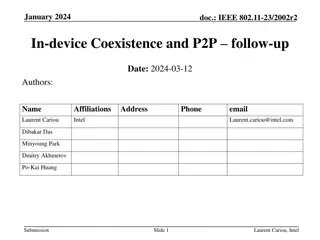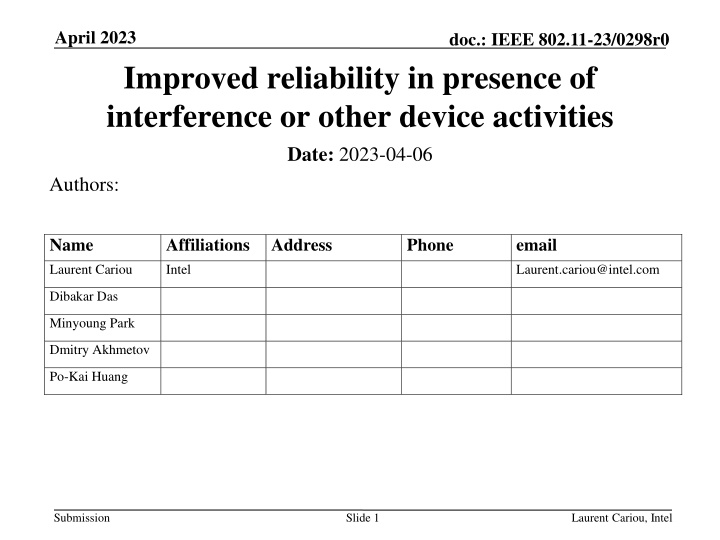
Improved Reliability in Wireless Networks: Addressing Interference Challenges
Explore solutions to enhance reliability in wireless networks amidst interference issues such as in-device coexistence with Bluetooth, unpredictable interference scenarios, and difficulties in informing infrastructure APs of STA constraints. Learn about the complexities in managing interference and potential strategies for improved network performance.
Download Presentation

Please find below an Image/Link to download the presentation.
The content on the website is provided AS IS for your information and personal use only. It may not be sold, licensed, or shared on other websites without obtaining consent from the author. If you encounter any issues during the download, it is possible that the publisher has removed the file from their server.
You are allowed to download the files provided on this website for personal or commercial use, subject to the condition that they are used lawfully. All files are the property of their respective owners.
The content on the website is provided AS IS for your information and personal use only. It may not be sold, licensed, or shared on other websites without obtaining consent from the author.
E N D
Presentation Transcript
April 2023 doc.: IEEE 802.11-23/0298r0 Improved reliability in presence of interference or other device activities Date: 2023-04-06 Authors: Name Laurent Cariou Affiliations Intel Address Phone email Laurent.cariou@intel.com Dibakar Das Minyoung Park Dmitry Akhmetov Po-Kai Huang Submission Slide 1 Laurent Cariou, Intel
April 2023 doc.: IEEE 802.11-23/0298r0 In-device coexistence issue In device coexistence with Bluetooth (BT) has always been an issue. So far, this was contained in the 2.4 GHz band only. BT will now be able to operate at both 5 and 6 GHz, which makes the problem bigger than it was before. EU Regulatory is already in process of enabling Bluetooth, ZigBee and BLE operation in 5 and 6 GHz band. There are other sources of interference other wireless technologies with multi-link operation, we have other sorts of interference that can arise, and that may be sometimes difficult to predict. Multilink NSTR operation is a good example where a transmission on one link by a STA of a non-AP MLD may impact the reception of a collocated STA of the same non-AP MLD by generating some cross-link interference, In-device coexistence (spurs, modulation between components, ) Submission Slide 2 Laurent Cariou, Intel
April 2023 doc.: IEEE 802.11-23/0298r0 Other activities A STA can be associated to an infrastructure AP and have P2P or mobile AP operation at the same time, Such STA typically needs to multiplex in time its operation for infrastructure AP and for P2P A STA currently uses power mode changes with infra AP in order to signal unavailabilities (very inefficient) Negotiation of TWT SP operation could help, but difficult to describe properly the client constraints, which makes negotiation difficult or impossible Lack of a clear mechanism for a STA to inform an infrastructure AP of its constraints for P2P operation, especially a clear indication of a Service Period or Period of Time during which the STA shall be considered as in doze state and unavailable Submission Slide 3 Laurent Cariou, Intel
April 2023 doc.: IEEE 802.11-23/0298r0 Predictable/unpredictable interference 1 Some interference may be predictable For such interference, tools are needed in order to define properly the period during which the interference occurs, and possibly characterize the interference Some BT can be scheduled in some cases 2 Other interference are difficult to predict long in advance This is often the case for BT interference We therefore need solutions in order to react properly when interference occurs, and not have reactions that impact even more a Wi-Fi connection. 3 Other possible interference situation Some interference are in the middle For instance, periodicity for interference period is known, but interference may not always occur during such period Submission Slide 4 Laurent Cariou, Intel
April 2023 doc.: IEEE 802.11-23/0298r0 Interference impact Obviously, when interference occurs, it impacts ongoing transmissions/receptions Reducing SINR if interference occurs during reception, often leading to packet losses Or forcing unavailability of the STA with very short notice Stopping ongoing transmission if priority is given within the device for another wireless technology, Double punishment: When interference occurs to a received PPDU and causes packet losses, not only can some packets be lost, but the rate selection mechanisms on the transmitter side may get adjusted to lower the rate of subsequent transmissions, as the transmitter does not know that the packet losses was not due to the channel conditions but was due to unexpected and infrequent interference. Submission Slide 5 Laurent Cariou, Intel
April 2023 doc.: IEEE 802.11-23/0298r0 Proposals for 1) predictable interference and other predictable activities on client side Need a tool to inform the AP of SPs during which the STA is unavailable because of in-device coexistence, or because it is performing other functions (scanning, P2P, ) * Need a tool so that the STA can inform the AP of when these period will happen, and whether they are periodic or not During these periods, the AP shall consider the STA in doze state *Also a very useful tool to ensure that a regular infrastructure AP that wants to do power save will efficiently select its power save inactivities As described previously, in some situations, the interference will impact only some frequencies (only some subcarriers) and either during a restricted time or possibly all the time (spurs, ) Need to be able to report interference on a specific frequency zone (RU for instance) In such case, normative behavior on AP side would then be similar to the following: AP shall apply a static puncturing specifically for operation with the STA AP shall assign to the STA only RUs that don t overlap with this interfered region Submission Slide 6 Laurent Cariou, Intel
April 2023 doc.: IEEE 802.11-23/0298r0 Proposals for 1) predictable interference and other predictable activities on client side Define a new signaling for such interference/unavailability reporting Or reuse and enhance existing tools and make it mandatory Colocated Interference Report element Provides most of the needed signaling for reporting interference Misses the normative behavior on AP side (consider STA in doze state): easy to add Reusing TWT is less straightforward and TWT already complex: STA sends unsolicited TWT Response frame, including a TWT element describing the service period(s) with an explicit indication (e.g. Responder PM) that the STA will be unavailable during that SP (reverse concept than today), and ensure that no other TWT rules would apply. Submission Slide 7 Laurent Cariou, Intel
April 2023 doc.: IEEE 802.11-23/0298r0 Proposals for 2) unpredictable interference a) Add signaling in BA in case of unexpected interference to ensure no double punishment (explained before) b) Shortening/truncation of a TxOP due to upcoming interference, as a TxOP responder or TxOP holder Submission Slide 8 Laurent Cariou, Intel
April 2023 doc.: IEEE 802.11-23/0298r0 2) a) Rate selection in case of interference We propose to add a signaling indication in a BlockAck frame that is sent (by a responder) as immediate response to a PPDU transmission (sent by an initiator) in order to indicate to the initiator of the PPDU that the PPDU reception suffered from an unusual interference, which was the main cause of packet losses. Could be a simple 1-bit field to indicate that the PPDU reception suffered from interference or not or it could be more advanced to locate more accurately the interference impact if needed Expected behavior: Initiator will not take into account statistics of this PPDU for updating its rate selection algorithm Note that this could fit in the more general Link adaptation mechanism (rate selection based on feedbacks in the BA) if we define one in UHR Submission Slide 9 Laurent Cariou, Intel
April 2023 doc.: IEEE 802.11-23/0298r0 2) a) Rate selection in case of interference Continued.. If the transmitter already dropped the rate, it would also be good to have a way to bring the rate back up This can be a complementary signaling to specifically ask to go back to immediately preceding rate As mentioned in previous slide, this can fit in a more general link adaptation mechanism in BA, such as a simple tool to ask to go up one rate, go down one rate, or keep current rate Submission Slide 10 Laurent Cariou, Intel
April 2023 doc.: IEEE 802.11-23/0298r0 2) b) TxOP shortening/truncation Define a mechanism so that a recipient of a PPDU transmission can indicate, at the beginning of the TxOP that it will be available only until a specific point in time, and not after because it knows an interferer will be present at that time Max availability period indication in CTS frame, using signaling equivalent to Dynamic Bandwidth negotiation or alternatively using the Duration field by modifying the duration field setting rules or as an A-ctrl feedback similarly to BQR feedback Points to TxOP end time RTS Duration 5ms AP STA CTS Duration 1ms Points to a time after which the STA will be unavailable Similar feedback can be provided in a BA frame during a TxOP for completeness Submission Slide 11 Laurent Cariou, Intel
April 2023 doc.: IEEE 802.11-23/0298r0 2) b) TxOP shortening/truncation PPDUs could also be shortened/truncated: If we define a preemption mechanism (see other discussions), we can use it so that initiator and even a responder can terminate early a PPDU in case of sudden interference or decision to prioritize another wireless technology example with preemption period between PPDUs Preemption period/pause Full contention period 1 ms 1 ms 1 ms 1 ms BA Initiator terminates early (TS: termination signal (could be a CF-end)) Indication needed for BA, if needed Full contention period TS 1 ms 1 ms Interference BA Time Initiator is aware of incoming interference Submission Slide 12 Laurent Cariou, Intel
April 2023 doc.: IEEE 802.11-23/0298r0 Conclusion UHR is the opportunity to improve reliability in presence of interference or other device activities We propose several solutions, for predictable or unpredictable interferences/activities Long term indication of periodic service periods during which a STA shall be considered in doze Signaling in BA in case of unexpected interference to ensure no double punishment (unfavorable rate adaptation) Shortening/truncation of a TxOP due to upcoming interference, as a TxOP responder or TxOP holder Submission Slide 13 Laurent Cariou, Intel

